|
Date |
Manufacturer |
Notes |
Outside of
Box |
Inside of
Box |
|
1928 |
NOMA |
This is NOMA's
number 190 battery outfit, shown in the first catalog the company
published. The set was offered with either
3 1/2 volt lamps for use with a dry cell battery, or with 6 volt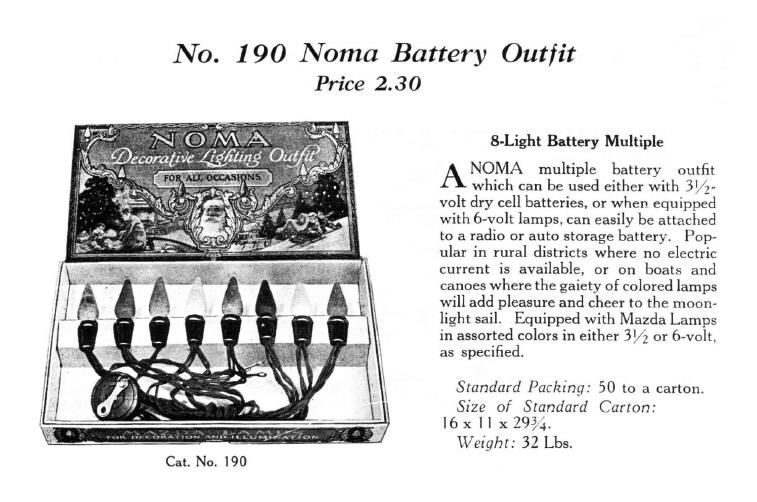 lamps for use with a radio or automobile battery. This is a very
hard outfit to find. The sockets are made of wood, and the set is
parallel wired. Also shown here is the listing from NOMA's original
catalog.
lamps for use with a radio or automobile battery. This is a very
hard outfit to find. The sockets are made of wood, and the set is
parallel wired. Also shown here is the listing from NOMA's original
catalog. |
 |
 |
|
1928 |
NOMA/Propp |
This outfit can be
found with both blue and green (pictured below) box covers. An unbranded outfit first
produced in 1928 by NOMA/Propp, the blue cover boxes are usually
found with lamps of Japanese manufacture, simply marked "tungsten"..
The blue box was an effort to use up huge amounts of the materials
NOMA acquired in the 1928 merger with Propp, and is the earliest of
the two types. |
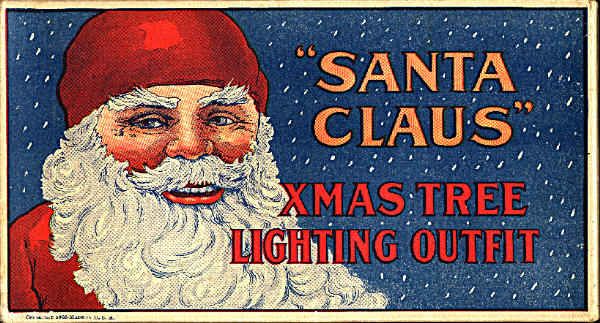 |
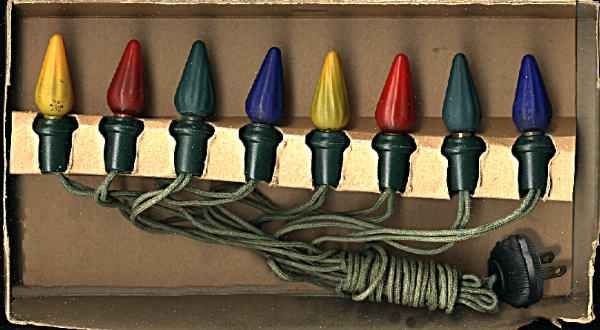 |
|
ca 1928 |
Real Lite |
One of the
prettiest boxes of its time, this set by Real Lite features early
outside painted C-9 intermediate based lamps. This box style was
also used for C-6 miniature based outfits as well. Sometime after
about 1929, the company was purchased by NOMA, who continued to use
the Real Lite name. |
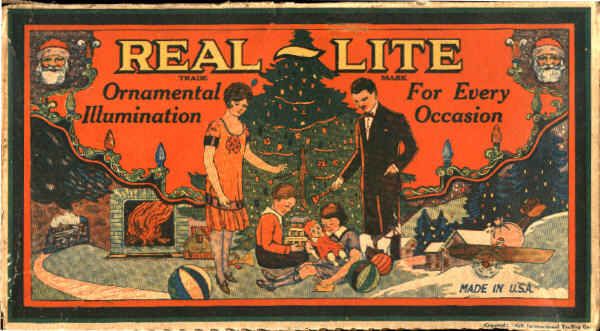 |
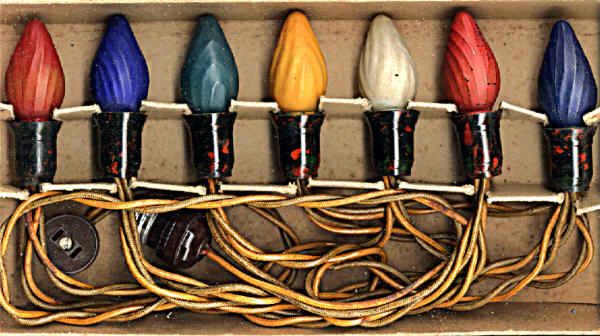 |
|
1928 |
NILCO |
The Novelty Incandescent
Lighting Company sold these lights in an almost identical box to the
one that Real Lite used (above). The two companies were not related,
but did buy their boxes from the same printing company. NILCO made
their own lamps and strings, and both are marked with the company
name. For more on NILCO, click HERE. |
 |
 |
|
ca 1928 |
NOMA |
This charming
little automobile wreath was offered in NOMA's first catalog, but
disappeared from subsequent issues. The instructions say to power
it from the tail light, stop light or dome light socket. The
connector has a typical automobile type bayonet base. Note the
original price tag, marked 85¢. |
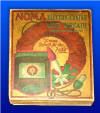 |
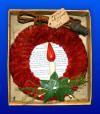 |
|
ca 1928 |
Unknown |
This set is often
attributed to a company called I.C. Young, but that company was a
folding box manufacturer, not a decorative lighting company. This
1928 issue is actually an unbranded generic outfit, made to be sold
cheaply, usually with less expensive lamps. Many of these sets exist
to this day. |
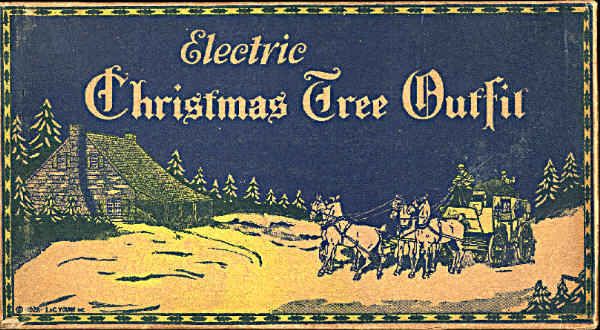 |
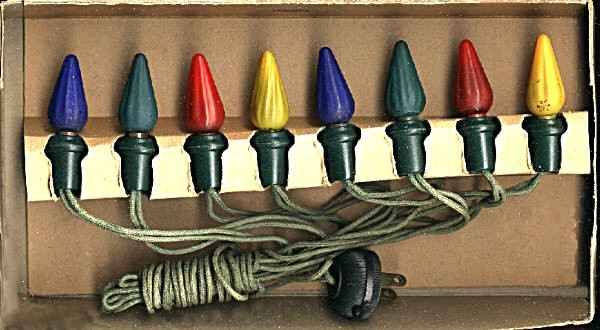 |
|
Circa 1928,
here is a very interesting indoor lighting set from Gacor, a
small appliance and electrical novelty company. Utilizing
eight intermediate base C-9 lamps wired in pairs and called a
"Multiple Twinkle Set", the outfit has a control box (pictured
below, third image from the left) that randomly flashes each
of the four pairs of lights. This is the first outfit on the
market that would allow a true "twinkling" effect, as other
twinkling lights of the period flashed the entire string on
and off at once. The set was offered first in 1922 using
miniature base C-6 lamps, and later in 1928 with the
intermediate base C-9 lamps as shown below. When the
candelabra base lights came out in 1934, Gacor offered a set
featuring those lamps as well. All three types of
outfits were sold through about 1936, when the effects of the
Depression made the $6.00 sets too expensive to sell. The
price for the set is printed on the inner flap of the box as
pictured below and to the far right.
The control box has a red switch that allows the lights to
either randomly twinkle or burn steadily, and uses a simple
bi-metallic system to flash the lights. This system has two
strips of different metals wired into each pair of light
strings. As current passes through these strips, one of them
heats up a bit and curls away, breaking the circuit. It cools
again almost instantly, again closing the circuit and lighting
the lamps, and the cycle then repeats for as long as power is
applied. Different lengths of wire for each socket allow the
lights to be easily distributed about the tree for the most
pleasing effect. It is unusual for C-9 intermediate base lamps
to be specified for indoor use, as they were invented
specifically to be durable and weatherproof outside, but this
outfit is decidedly not weatherproof and could not safely be
used outdoors. The system is quite ingenious and well made,
and really produces a nice effect on the Christmas tree. Note
the unusual metal sockets in the set as shown in the picture
below. |
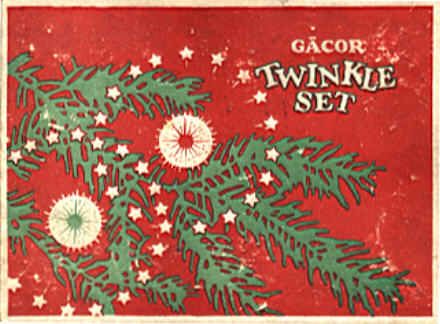
Outside of box |

Inside box |

Twinkle Control |
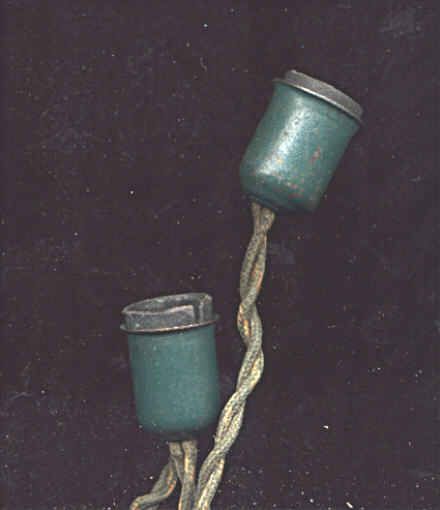
Metal Sockets |

Inner flap, showing $6.00 price |
|
|
ca 1929 |
NOMA/Propp |
The green
NOMA/Propp boxes most often contained Japanese lamps, and many are
so marked. Similar boxes can be found with no indication of lamp
type marked at all. This set was a "loss leader", offered
inexpensively. The green boxes are always of much thinner
construction than are the blue boxes (pictured above). |
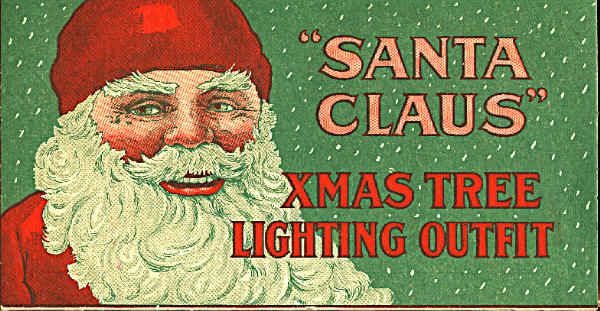 |
 |
| ca
1929 |
NOMA |
While
this NOMA box cover bears a 1927 copyright date, its use began
in 1929. This box is an example of the less colorful
 NOMA
outfits produced during the Depression years. (Compare to the full
color version shown at the left.) Additionally, the outfit bears
advertising on the bottom of the box as well, unusual for any lighting company. NOMA
outfits produced during the Depression years. (Compare to the full
color version shown at the left.) Additionally, the outfit bears
advertising on the bottom of the box as well, unusual for any lighting company. |
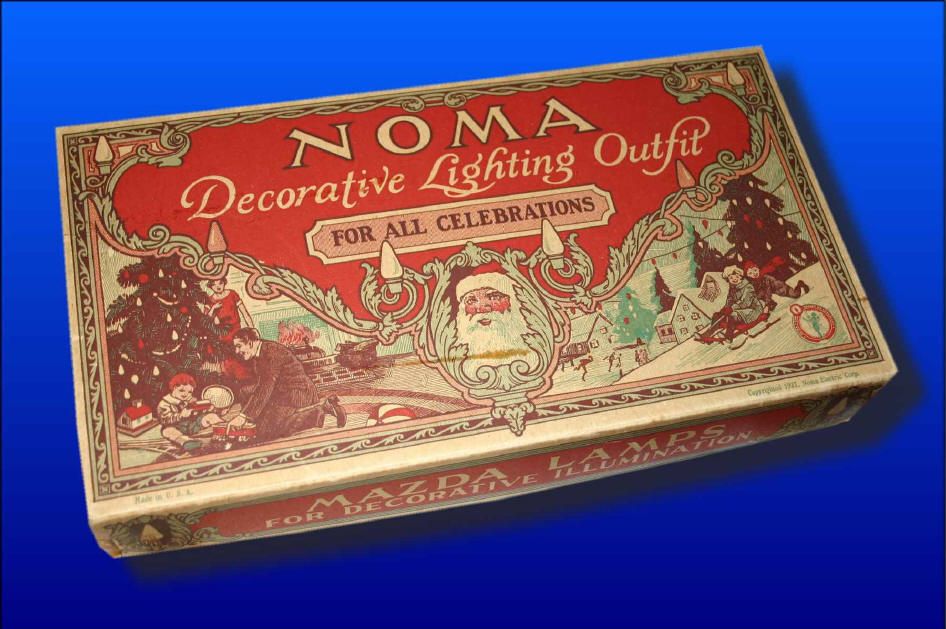 |
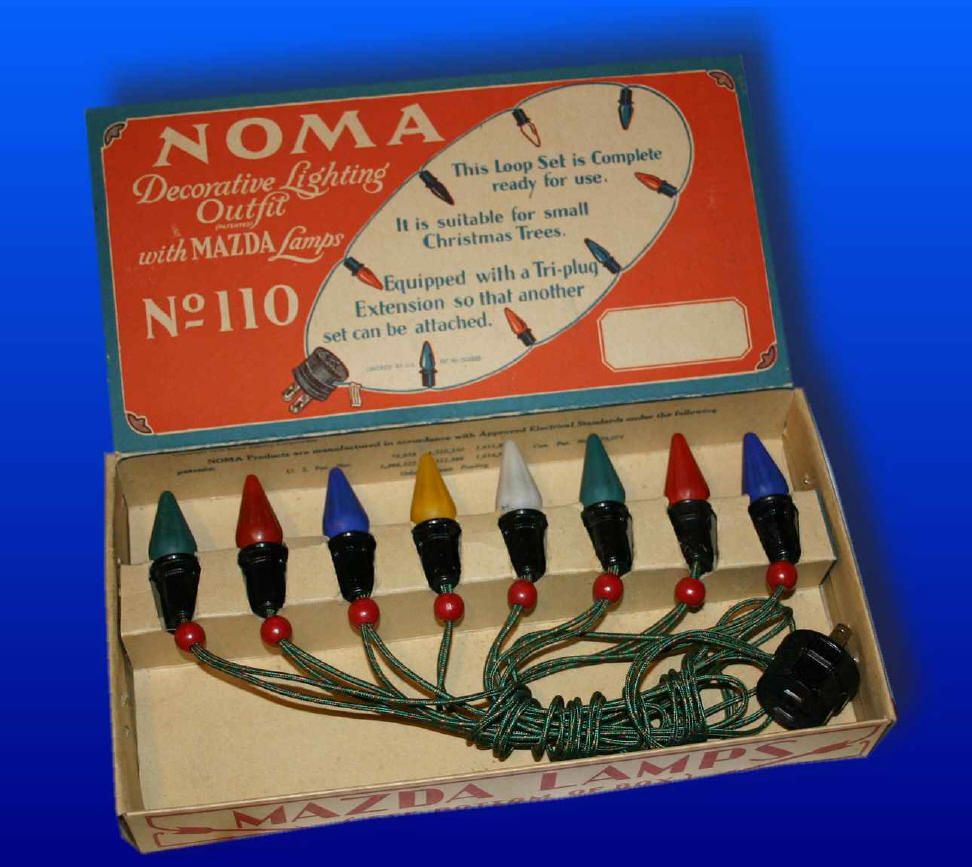 |
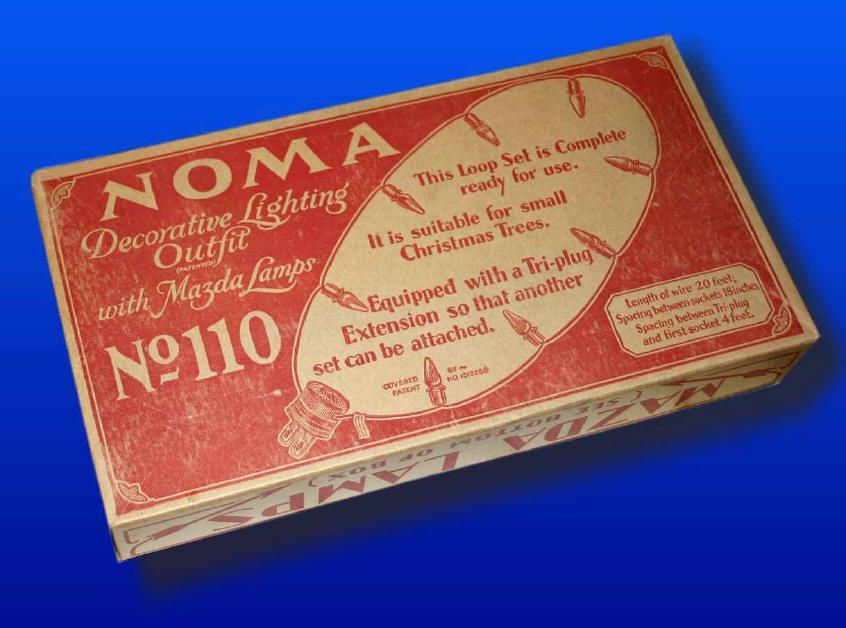 |
| ca
1929 |
Real
Lite/NOMA |
By the time this
set was sold, NOMA had purchased the manufacturer, but was still
selling the set in its original box. NOMA soon changed over to their
own boxes, but kept the Realite name for use with its imported
outfits. This outfit specifies the use of Japanese lamps, and is
equipped with colorful "snow tip" lamps that are painted in two
different colors, fading into each other. |
 |
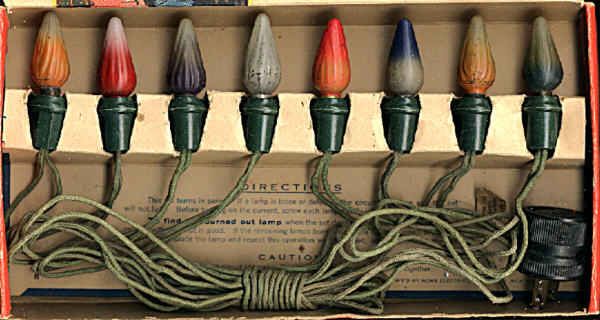 |
| ca
1929 |
Reliance |
The string is an
example of the use of Bakelite sockets. The earliest Bakelite sockets
were mottled with red and green, while later examples are usually
solid brown or black in color. |
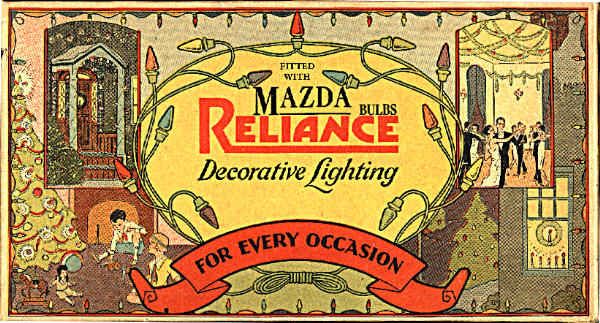 |
 |
| ca
1929 |
ClemCo |
This is ClemCo's
earliest C-9 outdoor outfit, and is a difficult box to find. The
light string sold with this set has a brand name of Meteor, and is a
high quality Underwriter's listed cord which was equipped with the
more expensive General Electric Mazda inside colored lamps and clips
for positioning the lights |
 |
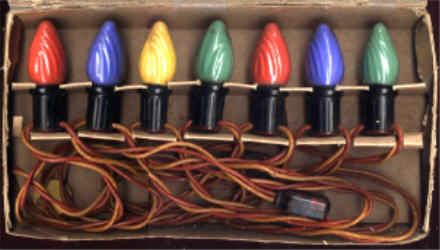 |
| ca
1929 |
Thomas Imports |
This outfit from
Thomas Imports is quite typical of the late 1920s imported outfits.
The lighting string is American made, while the C-6 miniature base
lamps are of Japanese origin. Many varieties of sets like these were
sold over the years, as a less expensive alternative to outfits
totally of American manufacture. |
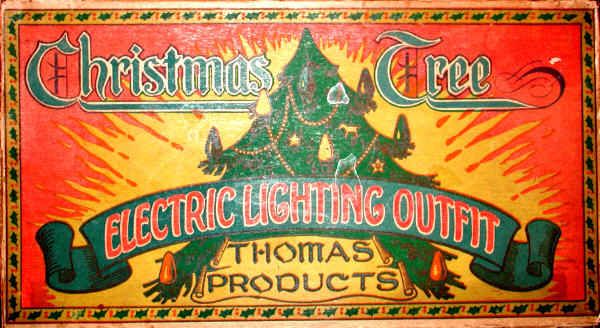 |
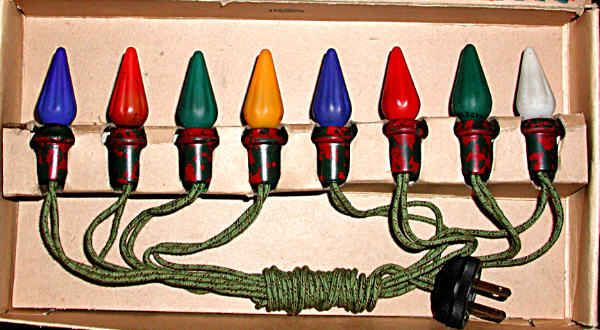 |
| ca
1929 |
Thomas Imports |
Produced by Thomas
Imports, or Timco, this outdoor set always came from the factory
with imported C-9 intermediate base lamps. The light string on this
outfit is lacquered cotton, the earliest form of weatherproofing. As
the string aged, the lacquer would harden and become stiff, making
the set unusable. Storage in extremely warm places such as attics or
garages added to the stiffening problem, and later outdoor sets
would use rubber coated wires to alleviate this problem. This set
remains quite flexible due to the fact that it was stored indoors
and away from heat and humidity. |
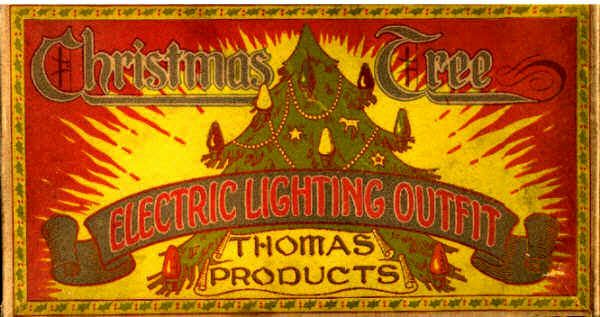 |
 |
Welcome Page
TABLE OF CONTENTS
BACK NEXT
|
|

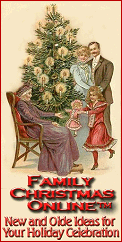
|

































